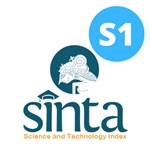Occupational Stress in Landing Platform Dock (LPD) Project Workers of PT. PAL Indonesia
Downloads
Introduction: Occupational stress is a condition in which the body responds physiologically, psychologically, and also behaviorally towards stressor. It can have negative effect on the workers and the workplace. The objective of this research is to study occupational stress and factors related to it in workers at Landing Platform Dock (LPD) project, especially Merchant Ship Division of PT PAL Indonesia. Methods: this research is an observational descriptive research. The subjects of the research are all the 32 workers of the project. The variables are occupational stress, individual characteristic, and work environment. Data was analyzed to discover the correlation between variables using contingency coefficient and Spearman correlation. Results: of the total 32 workers, 21.8% suffer from mild stress, 68.8% suffer from moderate stress, and 9.4% suffer from severe stress. Statistical test results show that there is a moderate correlation between level of education (coefficient -0.446), workload (coefficient 0.533), and relationship at work (coefficient 0.494) toward occupational stress. Meanwhile, personality factor (coefficient 0.334) and marital status (coefficient 0.231) have a weak impact on occupational stress. Furthermore, age (coefficient 0.146) has an extremely weak impact on occupational stress. Conclusion: factors that highly contributes to occupational stress are education level, workload, and relationship at work. Other factors such as age, personality type, and marital status only have a small correlation with occupational stress in these workers.
Keywords: individual characteristic, occupational stress, work environment
Aghaei, M. et al. (2013) ‘The Relation between Personality Type, Locus of Control, Occupational Satisfaction and Occupational Exhaustion and Determining the Effectiveness of Stress Inoculation Training (SIT) on Reducing it among staffers of Saipa Company', Research Journal of Recent Sciences, 2(2), pp. 6–11.
Candraditya, R. (2016) The Relationship between Noise Levels and Job Stress in Workers at PT Vale Indonesia. Undergraduate Thesis. Surabaya: Faculty of Public Health Universitas Airlangga.
Failasufa, I., Pawenang, E. T. and Indarjo, S. (2014) ‘The Relationship between Noise and Heat Pressure with Job Stress in Spinning Section Workers', Unnes Journal of Public Health, 3(4), pp. 1–8.
Health and Safety Executive (2017) Work-related Stress, Depression, or Anxiety Statistics in Great Britain 2017, United Kingdom: Health and Safety Executive.
Irkhami, F. L. (2015) ‘Factor Associated with Job Stress in Divers at PT X.', The Indonesian Journal of Occupational Safety and Health, 4(1), pp. 54–63.
Karima, A. (2014) Factors Associated with Job Stress in Workers at PT X In 2014. Undergraduate Thesis. Jakarta: Faculty of Medicine anda Health Science Universitas Islam Negeri Syarif Hidayatullah.
Manuaba, A. (2000) Relationship between Workload and Work Capacity. Jakarta: Rineka Cipta.
Munandar, A. S. (2001) Industrial and Organizational Psychology. Jakarta: Universitas Indonesia Press.
Ogden, J. (2012) Health Psychology. New York: McGraw Hill.
Panengah, Y. I. (2012) The Relationship between Workload and Job Stress for Workers in Wirun Gamelan Industrial Center Sukoharjo. Undergraduate Thesis. Surakarta: Faculty of Medicine Universitas Sebelas Maret.
Pestonjee, D. and Pandey, S. (2013) Stress and Work: Perspective in Understanding and Managing Stress. India: India: Sage Publishing.
Wijono, S. (2012) Industrial and Organizational Psychology. Revision. Jakarta: Prenada Media Group.

In order to be accepted and published by The Indonesian Journal of Occupational Safety and Health, Author(s) who submit an article should complete all the review process. The copyright of received articles assigned to the The Indonesian Journal of Occupational Safety and Health and Department of Safety and Health, Universitas Airlangga as publishers of the journal. The intended copyright includes the rights to publish articles in various forms (including reprints).
The Editorial Team of The Indonesian Journal Of Occupational Safety and Health and Department of Safety and Health strive to ensure that no errors occur in the articles that have been published, both data errors and statements in the article.
Users of this website will be licensed to use materials from this website following the Creative Commons Attribution-NonCommercial-ShareAlike 4.0 International License. No fees charged. Please use the materials accordingly.
------------------------------------------------------------------------------------------------------------------------------------------------------------------------------------------
Attribution ” You must give appropriate credit, provide a link to the license, and indicate if changes were made. You may do so in any reasonable manner, but not in any way that suggests the licensor endorses you or your use.
NonCommercial ” You may not use the material for commercial purposes.
ShareAlike ” If you remix, transform, or build upon the material, you must distribute your contributions under the same license as the original.







 How to Submit Articles in OJS
How to Submit Articles in OJS

























